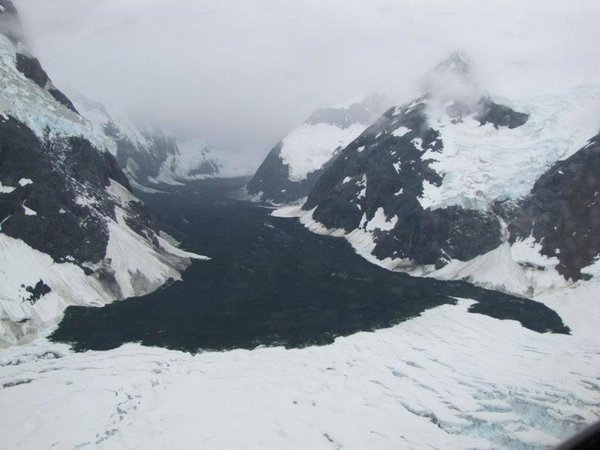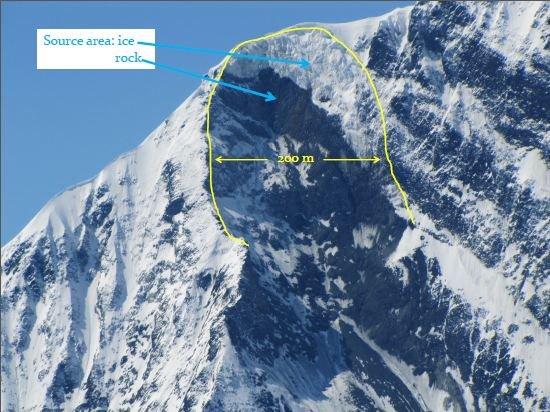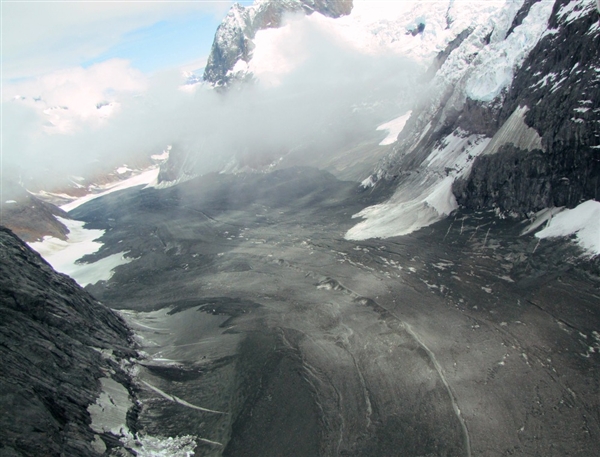
Located in a remote area of Glacier Bay National Park, the slide was so big it registered on earthquake monitors as a magnitude 3.4 event.
Officials noticed the monitor blip on June 11 but it wasn't until July 2 that a pilot passing over the site took photos that showed just how large it was, Glacier Bay National Park announced on its Facebook page.
Larger landslides have happened over geologic history, Marten Geertsema, a natural hazards researcher for the Forest Service in nearby British Columbia, told msnbc.com, but it certainly was "one of the longest runout landslides on a glacier in Alaska and Canada in recent times."
Moreover, the force was enormous, Geertsema said. No one was present, but had anyone been there they probably "would be blown over by the air blast," he told the Associated Press.
Officials ruled out an earthquake as the trigger that caused part of the nearly 12,000-foot Lituya Mountain to give way, smothering the ice-white Johns Hopkins Glacier with dark rock and debris over an area a half-mile wide and 5.5 miles long.
Another possibility is that thawing permafrost, which is ground that stays frozen for two more our years, caused the slide.
"We are seeing an increase in rock slides in mountain areas throughout the world because of permafrost degradation," said Geertsema.
"I don't know whether permafrost degradation played a role here, but we can be almost certain that permafrost exists on Lituya Mountain," said Geertsema, who reviewed aerial photos of the mountain and slide area. "Certainly this type of event could happen from permafrost degradation."
Many areas of mountain permafrost have been thawing in recent decades as temperatures warm, and some experts are becoming convinced that thawing is a factor in the frequency of rock slides, Geertsema said, pointing to data by Swiss scientists studying the Alps.

"Certainly we are seeing an increase in large landslides over the past decades," he added, citing his 2006 study that found between 1973 and 2003 the average in northern British Columbia increased from 1.3 large landslides per year to 2.3.
Moreover, he said, most of the slides in northern British Columbia are happening in the warmest years.
Glacier Bay park ecologist Lewis Sharman told National Parks Traveler that experts figure such landslides will become "a little more frequent as we have warmer-than-usual temperatures, we have more melting events, and glaciers and surface sediments become better lubricated on surface terrain at elevation."
The slide was miles from areas used by park visitors, most of whom see Glacier Bay by cruise ship.
"You can't see it from a boat or the bay. You've got to be up flying. And it's not on a typical flying route," park service spokesman John Quinley told Reuters. "It would have been pretty horrific if you'd been camped on the glacier."
And it won't reach the bay for a long time."The landslide is approximately 12-14 miles up the glacier," the park said on its Facebook page, and the glacier itself moves material towards the bay only about 10-15 feet a day. "So this debris may not reach the face of the glacier for many years," it added.
Officials are currently trying to estimate the volume of material that fell in the slide.
In 1958, a nearby landslide, this one above Lituya Bay, created a wave hundreds of feet high that washed 1,720 feet up a narrow inlet. Two people on a fishing boat vanished and three others on land were killed.
One fishing vessel was able to ride out the wave, Geertsema noted.
"They looked below them and they could see the tops of the Sitka spruce trees way below," he said. "The other boat disappeared."




Reader Comments
to our Newsletter